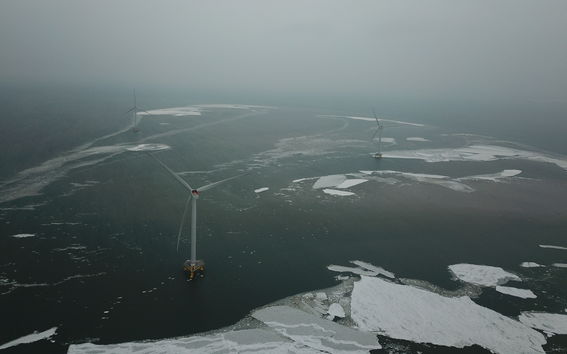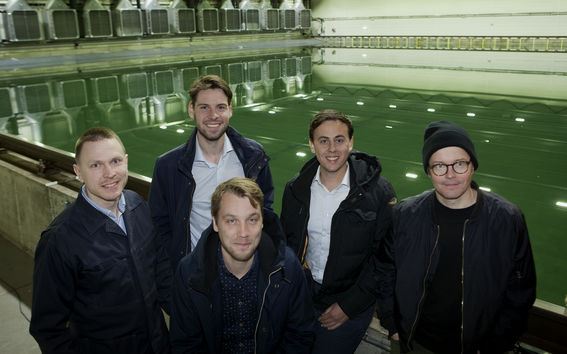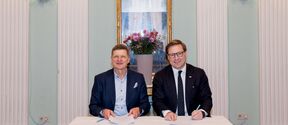SHIVER – An advanced ice model for designing offshore wind turbines

The goal of the new consortium project SHIVER by Delft University of Technology, Aalto University and Siemens Gamesa Renewable Energy is to develop an advanced model, which can be used when designing and optimizing offshore wind turbines that are susceptible to ice-induced vibrations. These vibrations are commonly considered to be the one of the major threats to wind turbines built in ice.
The drive for green and sustainable energy production pushes the production of wind energy towards ice infested waters. The economic feasibility of wind energy production largely depends on the solutions used in building it. Accurate models provide information and tools for novel designs, and more sustainable and economically feasible structures.
‘In TU Delft we have been for years studying ice interaction with offshore structures in relation to hydrocarbon extraction and the ice-induced vibration of these structures. This topic has recently become very relevant for offshore wind turbines’, says Professor Hayo Hendrikse from Delft University of Technology.
‘The idea is to develop a simulation model to quantify the ice loads on these structures during the non-linear interaction between ice and structure. There are still many open questions in ice mechanics related to this; what exactly happens in the ice-structure interface during the interaction process is not known. This is the first time anybody will study this topic using a model-scale offshore wind turbine in a laboratory-scale ice model test’, he continues.
The model-scale experiments will take place in Aalto Ice Tank in Otaniemi
‘Full-scale tests would be expensive and challenging to perform reliably, and Aalto University has a unique facility for executing this type of experiment; a large square-shaped test basin where an ice cover can be generated for testing the impact of ice loads on model-scale structures. The tank is the key for successful international collaboration in SHIVER’, says Professor Arttu Polojärvi from Aalto University’s Arctic Marine Technology and Ice Mechanics research group.
‘In Aalto we put a heavy emphasis on numerical ice mechanics as the ice loads are caused by a complex ice-structure interaction process. Simulations allow detailed observations, but they must always be validated against experimental data. Aalto Ice Tank is an ideal platform for this.’, he adds. ‘The collaboration in SHIVER is important for us in Aalto as we can combine our strengths with those of TU Delft and with the vision of Siemens Gamesa on commercial offshore wind energy production.’
“We have a long history of collaboration with TU Delft in research projects. The knowledge gained from these projects enables us to design using state-of-the-art techniques and methods. We participate in the SHIVER project to close the knowledge gaps related to the dynamic effects that sea ice can have on offshore wind turbines. This allows for more economical support structure designs for future wind farms in, for example, the Baltic Sea”, says Tom Willems from Siemens Gamesa.
SHIVER
An advanced ice model for application in design of offshore wind turbines susceptible to ice-induced vibrations based on model-scale experiments.
Duration: 2019–2024
Partners: Delft University of Technology, Siemens Gamesa Renewable Energy, Aalto University
Funding: TKI Wind op Zee

Aalto Ice Tank is a unique 40 x 40-meter ice basin. Typical ice tank experiments include resistance, propulsion and maneuvering tests on ships in ice, tests on ice loads on marine structures, and modelling of natural ice formations, such as ice ridges and ice rubble. Aalto Ice Tank also enables a wide range of other experiments on the physical phenomena related to sea ice, such as experiments on ice fracture, and offers a platform for rigorous validation of numerical models.
Read more news

The semiconductor sector jobs open in research groups
Semi-Summer 2026 programme will provide an opportunity to gain the skills needed in a growing and international semiconductor sector.
New cooperation agreement between the City of Helsinki and Aalto University to strengthen a sustainable, vibrant and knowledgeable city
The main themes of the cooperation are vitality, innovations and entrepreneurship, as well as research cooperation and knowledgeable labour, drawing heavily on the research and education expertise of the university.
Start the year with new insights – apply for FITech's spring courses!
Deepen your knowledge with courses from Finnish universities of technology, designed to meet the demands of the working life and help deepen your expertise for free.






